It looks like you're using an Ad Blocker.
Please white-list or disable AboveTopSecret.com in your ad-blocking tool.
Thank you.
Some features of ATS will be disabled while you continue to use an ad-blocker.
share:
originally posted by: PuterMan
a reply to: BobAthome
Go to the Quake Watch thread and look at the recent post by Phoenix. A weaker Sun causes more radiation induced heat in the Earth's core. The Sun is weak at present.
The problem is we do not know why. As I see it, there are two possibilities.
1. When the sun goes dormant, other particles (that we do not know about) are emitted that causes the Earth to heat internally.
2 Particles are emitted by the sun that slow down or mitigate the heating effects of the core. Think of control rods in a nuclear reactor. If those particles slow, the Earth heats up.
It has to be one or the other and I am going for number 2 because of the research results that are already in.
news.stanford.edu...
P
a reply to: pheonix358
What an awesome discovery. a constant that can no longer be assumed constant. As I see it it adds more substance to the electric universe theory. I would tend to agree we will find a yet unknown form of energy or particle that influences the decay rate as well as many other things.
Thats wild that the suns core rotates at a different rate than the surface
What an awesome discovery. a constant that can no longer be assumed constant. As I see it it adds more substance to the electric universe theory. I would tend to agree we will find a yet unknown form of energy or particle that influences the decay rate as well as many other things.
Thats wild that the suns core rotates at a different rate than the surface
a reply to: muzzy
erm don't know if somone already pointed it out but that's not bardarbunga. Bardarbunga is just right to the fissure all the way to the radar r2d2 thing. It's HUGE. I believe the caldera is either right behind the fissure or just slightly to the right.
edit- found image
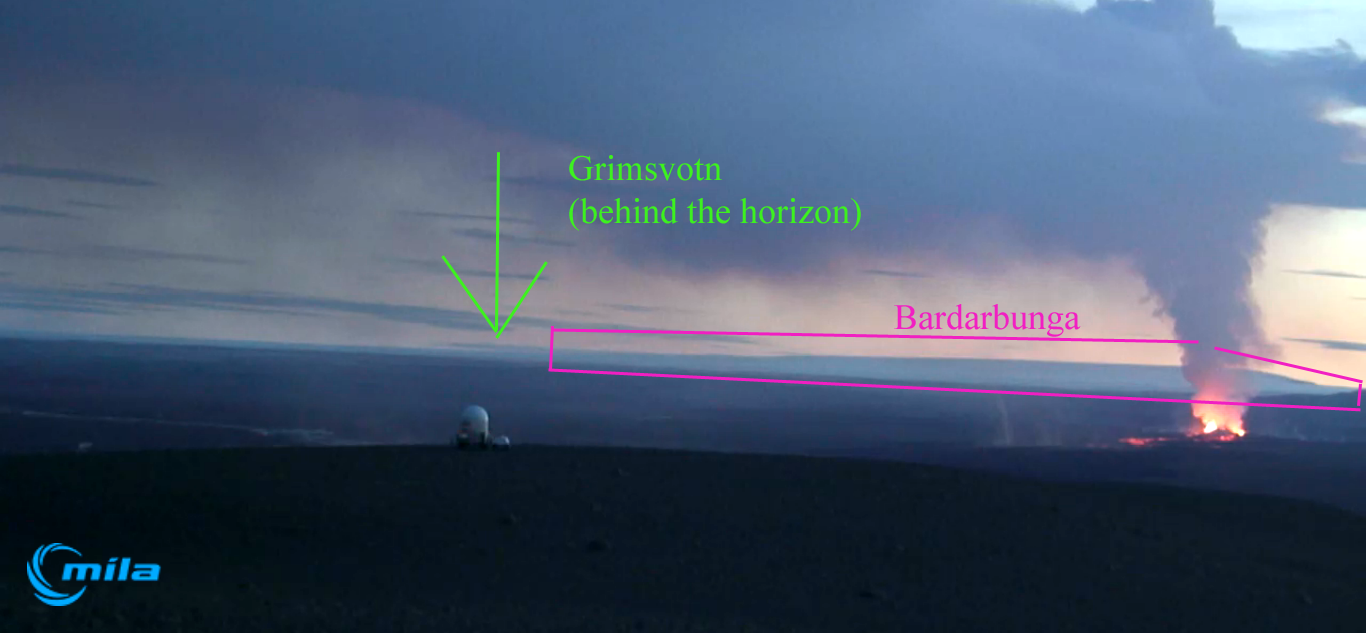
erm don't know if somone already pointed it out but that's not bardarbunga. Bardarbunga is just right to the fissure all the way to the radar r2d2 thing. It's HUGE. I believe the caldera is either right behind the fissure or just slightly to the right.
edit- found image

edit on Thursdaypm251430Thu, 25 Sep 2014 12:28:03 -0500282014-09-25T12:28:03-05:00k by LadyTrick because: (no reason
given)
Geez you guys are smart!! I easily understood everyone's input, thank you all!! Charts & graphs were great glad I come here 1st to see whats up
when I see something odd happening with the quakes or volcanoes.
Magnitude 5.0 quake within Bardarbunga caldera, depth 5,7km, confirmed.
Still no signs of caldera collapse, but it may happen without warning. The caldera itself could erupt without warning also. The current activity has continued for 6 weeks, as the first quake swarm started on 16th of August.
Still no signs of caldera collapse, but it may happen without warning. The caldera itself could erupt without warning also. The current activity has continued for 6 weeks, as the first quake swarm started on 16th of August.
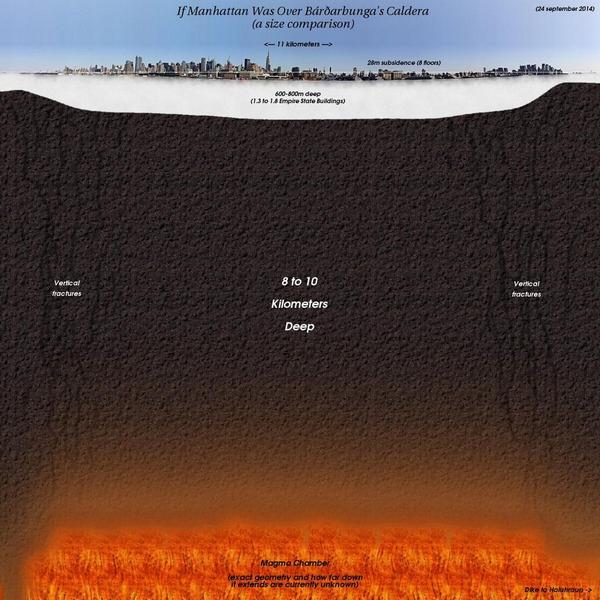
If Manhattan was over Bardabunga caldera...
sorry not sure what the original source of this image is as I got from twitter.
edit on Thursdaypm251430Thu, 25 Sep 2014 14:02:54 -0500022014-09-25T14:02:54-05:00k by LadyTrick because: s
a reply to: LadyTrick
thanks for pointing that out, yes I had it wrong!, I based it on the fact Bardarbunga was the biggest volcano in the view at 2009m, I didn't realize it took up the whole horizon.
What I marked as Bardarbunga must be Tungnafellsjokull @1535m? 474m, lower than Bardarbunga
or its a combination of Tungnafellsjokull and the cone Trolladyngja which is closer to webcam2 blurred together in the haze.
Of course I didn't just take your word for it, I had to recheck
Google Earth of the area dropped down to the level of Vadalda (web cameras) and looking at the same view as best I can as the panorama image, terrain set to 3 times height.
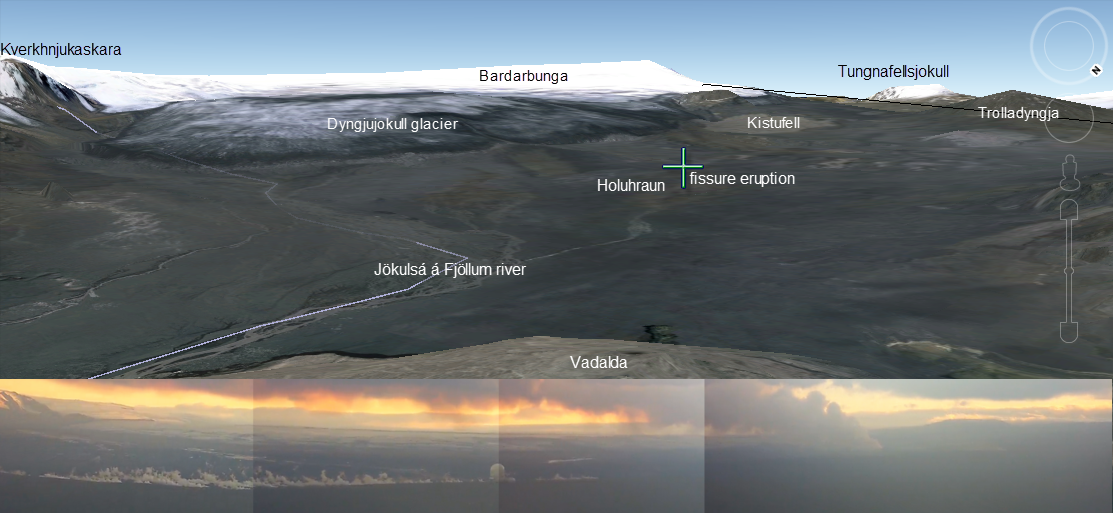
full size image here
Thanks again, lucky I hadn't posted it in my blog yet! could have been more embarrassing than it already is.
thanks for pointing that out, yes I had it wrong!, I based it on the fact Bardarbunga was the biggest volcano in the view at 2009m, I didn't realize it took up the whole horizon.
What I marked as Bardarbunga must be Tungnafellsjokull @1535m? 474m, lower than Bardarbunga
or its a combination of Tungnafellsjokull and the cone Trolladyngja which is closer to webcam2 blurred together in the haze.
Of course I didn't just take your word for it, I had to recheck
Google Earth of the area dropped down to the level of Vadalda (web cameras) and looking at the same view as best I can as the panorama image, terrain set to 3 times height.

full size image here
Thanks again, lucky I hadn't posted it in my blog yet! could have been more embarrassing than it already is.
The vertical displacement of the Bardarbunga caldera has stopped. It was getting lower, but this morning, around 6 am the displacement stopped. It
could continue again after another stronger earthquake, the caldera has always dropped after magnitude 5.0+ earthquake.

Enlarge (Source)

Enlarge (Source)
a reply to: batcrapcrazy
Yup and so does the Earth's but not as much.
www.sciencedaily.com...
Thats wild that the suns core rotates at a different rate than the surface
Yup and so does the Earth's but not as much.
www.sciencedaily.com...
a reply to: Thebel
has dropped some more since 00:00,
about another 18" (0.5m)
earthice.hi.is...
has dropped some more since 00:00,
about another 18" (0.5m)
24.09.2014, 11:00 UTC - Conclusions of the Scientific Advisory Board of the Icelandic Civil Protection:
Scientists from the Icelandic Met Office and the Institute of Earth Sciences and representatives of the Civil Protection in Iceland attend the meetings of the Scientific Advisory Board of the Icelandic Civil Protection. A representative from The Environment Agency of Iceland was also present.
The subsidence of the Bardarbunga caldera continues with same rate as before. The total depression, since the unrest started, is now between 27 and 28 meters.
earthice.hi.is...
Daily status report 25. September 2014 - compiled by IMO (Icelandic Met Office) and IES (Institute of Earth Sciences)
The volcanic eruption in Holuhraun continues with similar rate as last few days. The eruption does not seem to be declining. The lava field continues to grow and the lava production continues with the same strength. The subsidence of the Bardarbunga caldera continues with same rate as before.
They aren't giving much away are they?
Less quakes on the north end the last few days, at Holuhraun and Herdubreidartogl
seems more active at Bardarbunga itself
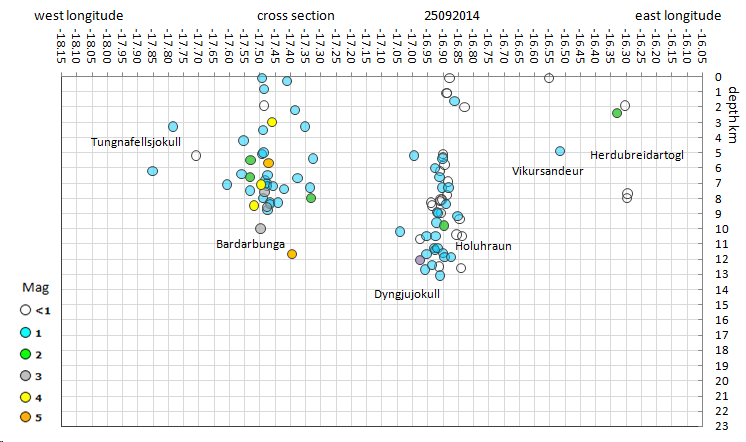
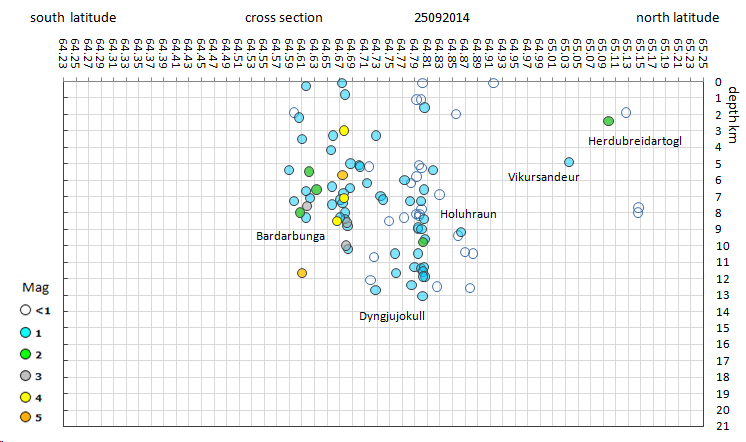
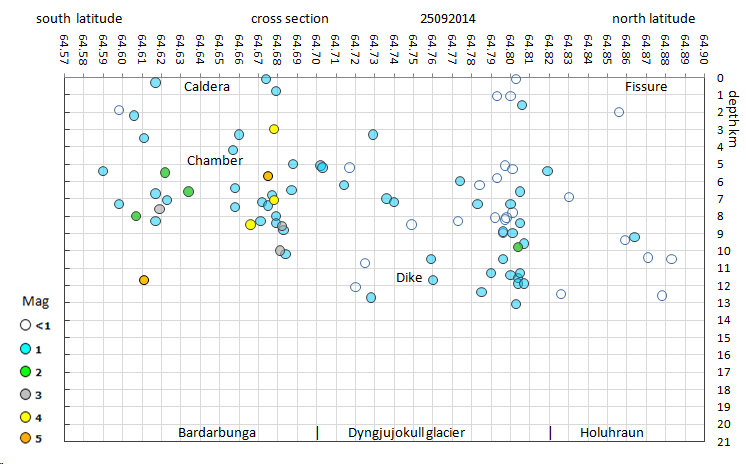
volcanictremor.wordpress.com...
a reply to: DAZ21
yes but I for one don't think that is likely now, the volcanos magma chamber is being "drained" from below out to Holuhraun.
One scenerio that the drop in earthquakes over the last few days outside the Vatnajökul Cap/Dyngjujokull glacier area could be presenting is; that the magma flow may be equalizing and doesn't have enough pressure (from Bardarbunga magma chamber) to flow with as much force to the open fissures as before. This would also account for the caldera floor to stop subsiding.
Hard to say, IMO aren't saying much about what is happening at the fissure.
yes but I for one don't think that is likely now, the volcanos magma chamber is being "drained" from below out to Holuhraun.
One scenerio that the drop in earthquakes over the last few days outside the Vatnajökul Cap/Dyngjujokull glacier area could be presenting is; that the magma flow may be equalizing and doesn't have enough pressure (from Bardarbunga magma chamber) to flow with as much force to the open fissures as before. This would also account for the caldera floor to stop subsiding.
Hard to say, IMO aren't saying much about what is happening at the fissure.
originally posted by: DAZ21
a reply to: Thebel
Do we have to start worrying if it heads in the other direction? Which would signify magma build-up?
Or is it really only a collapse that can lead to an eruption of the caldera?
I doubt that. It seems that the magma is escaping from under the caldera. That ice cap is heavy, so the magma pressure is not enough to lift the caldera. The magma is going towards Holuhraun magma field. But its impossible to know is more magma coming from somewhere. During first weeks of eruption, more magma was coming from deep down, but that could have changed now. But like I have said earlier, this is long-time event, could continue for months. Iceland is long overdue for volcanically significant event.
Some good news out of the Alaska Volcano Observatory:
Of course, the extra short period channels (EHZ) linked by AVO are broken, but you can see broadband and the short period channels of the new AV network stations CLES and CLCO on IRIS, here
This is good news, since Cleveland is still at "yellow alert" level.
While looking at the AVO site, it appears that Shishaldin may have had another decent eruption over the past few hours.
webicorder
No good views on the webcam at the moment.
The Alaska Volcano Observatory (AVO) announces the addition of seismic, infrasound, and web-camera monitoring equipment on Chuginadak Island in the eastern Aleutians. To our knowledge, these are the first-ever geophysical monitoring stations on and near highly active Cleveland volcano.
Of course, the extra short period channels (EHZ) linked by AVO are broken, but you can see broadband and the short period channels of the new AV network stations CLES and CLCO on IRIS, here
This is good news, since Cleveland is still at "yellow alert" level.
While looking at the AVO site, it appears that Shishaldin may have had another decent eruption over the past few hours.
webicorder
No good views on the webcam at the moment.
edit on 9/26/2014 by Olivine because: (no reason given)
web cams are blue at Vadalda
looks like its snowing!
en.vedur.is...
should be real pretty once the skies clear and see the eruption against the white background
maybe tomorrow afternoon
graph time again I guess
26th earthquake numbers are down 18.75% from yesterday (25th)
26th radiated energy released down 35.5% from yesterday (25th)
and the 25th was 33.3% down on the 24th for numbers too
but yesterday was up 17.8% for radiated energy released compared to the 24th
so less quakes but the less ones are more powerful (more 3's I think)
ach, a graph shows it better
looks like its snowing!
en.vedur.is...
should be real pretty once the skies clear and see the eruption against the white background
maybe tomorrow afternoon
graph time again I guess
edit on 0900000026926914 by muzzy because: (no reason given)
26th earthquake numbers are down 18.75% from yesterday (25th)
26th radiated energy released down 35.5% from yesterday (25th)
and the 25th was 33.3% down on the 24th for numbers too
but yesterday was up 17.8% for radiated energy released compared to the 24th
so less quakes but the less ones are more powerful (more 3's I think)
ach, a graph shows it better
edit on 09u26926914 by muzzy because: (no reason given)
Volcano erupting now in Japan
Wow, those people in that video were too close and ended up in cinder cloud coming from volcano. Great that the cloud wasn't too hot, but must have been unpleasant experience.
Central Japan’s Mount Ontake erupts; hikers reported injured
Mount Ontake, a volcano straddling Nagano and Gifu prefectures, erupted around 11:53 a.m. Saturday, leaving several hikers injured and stranded in mountain trails, local police and rescue workers said.
There was also unconfirmed information that some hikers were buried in volcanic ash, Nagano police said.
The Meteorological Agency said smoke billowing down the south face of the 3,067-meter volcano and stretching over 3 km was observed through a land ministry camera. The Nagano fire department has received several reports of injuries to hikers.
The agency is forecasting further eruptions that may affect nearby residents and is warning of volcanic cinder falling within a 4-km radius of the crater.
In Tokyo, Prime Minister Shinzo Abe set up an emergency task force and instructed relevant public authorities to get a handle on the situation and speed up the rescue operation of stranded hikers.
Japan Times
Wow, those people in that video were too close and ended up in cinder cloud coming from volcano. Great that the cloud wasn't too hot, but must have been unpleasant experience.
edit on 27-9-2014 by Thebel because: (no reason given)
Mount Ontake is quite unknown volcano. Its first historic eruption was in 1979 (VEI-1), it was thought to be inactive, until it started erupting that
year. There are no records of earlier eruptions, despite long history of Japan. And they haven't found any proof of earlier eruptions, so we know just
one eruption from its history. Now its erupting for the second time. Its the second-highest volcano in Japan. The caldera is 4 x 5 km wide, and its
largely buried. There are 4 stratovolcanoes in that same system, constructed 680 000 to 420 000 years ago. The volcano is popular destination for
pilgrims.
Incredible footage from RT
Incredible footage from RT
edit on 27-9-2014 by Thebel because: (no reason given)
new topics
-
Steering the Titantic from the Drydock.
US Political Madness: 2 hours ago -
Paramilitary Leaks - John Williams
Whistle Blowers and Leaked Documents: 11 hours ago
top topics
-
House Passes Laken Riley Act
Mainstream News: 14 hours ago, 23 flags -
What Comes After January 20th
Mainstream News: 17 hours ago, 18 flags -
Los Angeles brush fires latest: 2 blazes threaten structures, prompt evacuations
Mainstream News: 13 hours ago, 7 flags -
Hearing more ambulances lately
Medical Issues & Conspiracies: 13 hours ago, 7 flags -
Paramilitary Leaks - John Williams
Whistle Blowers and Leaked Documents: 11 hours ago, 6 flags -
Those stupid GRAVITE commercials
Rant: 17 hours ago, 5 flags -
Steering the Titantic from the Drydock.
US Political Madness: 2 hours ago, 5 flags -
The more I think about it
General Chit Chat: 15 hours ago, 4 flags -
Canada as a state .. how would it work?
General Chit Chat: 17 hours ago, 4 flags -
Some sausage, some chicken, some sauce, some onions and some garlic...and some peppers!
Food and Cooking: 13 hours ago, 3 flags
active topics
-
Canada as a state .. how would it work?
General Chit Chat • 18 • : YouSir -
Let's Buy Greenland
General Chit Chat • 18 • : CriticalStinker -
Meta Llama local AI system is scary good
Science & Technology • 50 • : ArMaP -
Gravitic Propulsion--What IF the US and China Really Have it?
General Conspiracies • 35 • : bastion -
Steering the Titantic from the Drydock.
US Political Madness • 3 • : ufoorbhunter -
-@TH3WH17ERABB17- -Q- ---TIME TO SHOW THE WORLD--- -Part- --44--
Dissecting Disinformation • 3968 • : AianawaQ1320 -
Post A Funny (T&C Friendly) Pic Part IV: The LOL awakens!
General Chit Chat • 8000 • : KrustyKrab -
Los Angeles brush fires latest: 2 blazes threaten structures, prompt evacuations
Mainstream News • 13 • : BeyondKnowledge3 -
House Passes Laken Riley Act
Mainstream News • 16 • : KrustyKrab -
Planned Civil War In Britain May Be Triggered Soon
Social Issues and Civil Unrest • 16 • : Freeborn

